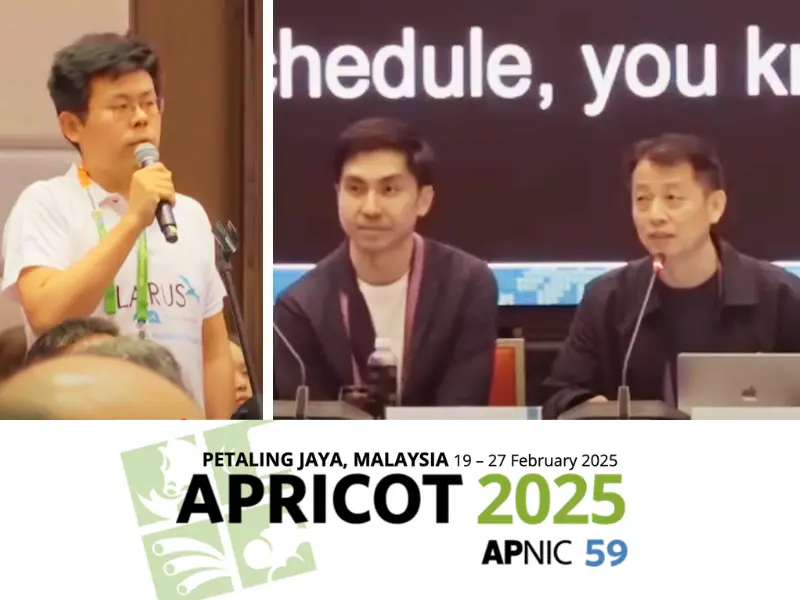- APNIC leadership faced scrutiny at the AGM over a lack of community engagement in updating ICP-2 and concerns about RIR accountability.
- Financial inefficiency and office costs were also criticized, with suggestions to cut expenses by downsizing operations and increasing remote work.
APNIC’s Executive Council has been grilled over its failure to proactively engage members of the Asia-Pacific internet community on the topic of ICP-2’s long-overdue update.
Speaking at the AGM held this week during the APRICOT event, Lu Heng, CEO at LARUS Ltd, was just one vocal member of the audience who wanted to hold APNIC to account. “I’ve been here all week, and I’ve not been approached even once to discuss ICP-2, one of the biggest updates taking place in this industry for years,” he said. “And many of the principles outlined in the report do not have the agreement of the community. Are we really going to push ahead with this aggressive timeline when the community disagrees with so much?”
Also read: Interview with Lu Heng: The man who wants to decentralise IP addresses and save the internet
Also read: Sponsor shock at APRICOT dinner: Canceled member now top supporter
Kenny Huang, APNIC Executive Council chairman, offered some explanation: “These things go through many stages, and some stages need more time to compile the data, so there may not have been time to consult all the necessary stakeholders, but we will address this in the future.”
ICP-2 proposals are ‘unrealistic’
But Lu had more points to make. Some of the proposals were illogical and unrealistic, he suggested. “It says that the RIRs [Regional Internet Registries] need to cooperate with ICANN and so on. But that’s like asking the criminal to cooperate with the police.”
He also pointed to the disconnect between the Regional Internet Registries. “The five RIRs operate entirely independently – independent back-end systems, independent billing systems, independent databases of members – they are not data sharing, there is no data escrow, so if an RIR fails there is no practical way to take over the membership and continue to guarantee uniqueness. This is a heavy burden considering the value of the assets in question – $200 billion.”
The $200 billion dollars refers to a hypothetical value of the 4.3 billion IPv4 addresses that exist, allowing devices on the internet to communicate with each other.
Also read: What is a Regional Internet Registry?
RIRs represent risk
Lu’s fear is that without an ironclad ICP-2 document, which is a set of principles that lays out how RIRs should operate, any company that relies on IPv4 addresses for its business is exposed to unnecessary risk. While the RIRs are meant to distribute and record the registrations of IP addresses, recent incidents in AFRINIC, the RIR for Africa, put these risks in the spotlight, when a senior executive was found to be selling IP addresses for his personal profit.
This kind of corruption is arguably inevitable, when you consider today’s value of these IP addresses, argues Lu, and to rush a new ICP-2 document without community involvement, and when many community members disagree with the proposals, is illogical, he says.
Lu also pointed to a flaw in how responses were collected. APNIC consolidated responses that were “near-identical”, supposing that some of these may have been computer- or AI-generated. Lu pointed out that this should not rule out any of the responses. “I myself use ChatGPT because it improves my English. And for most people here, the first language is not English. We should allow people to use whatever tools they need, especially if the inputs need to be in English, which a large proportion of the community does not speak, about a hugely important document that will connect the globe.”
Also read: What is AFRINIC? The role and challenges of the African Regional Internet Registry
APNIC’s finances scrutinized
And in another part of the meeting Lu criticized the financial efficiency of APNIC, especially regarding staff costs, and office expenses. “APNIC runs an operating budget of around AUD35 million (US$22 million),” he said. “Is it really necessary to have so many people just to run a registration database? Could some roles be outsourced? I run a bigger company than APNIC, and I have fewer managerial levels in my company.”
Lu also made some telling points about APNIC’s office building, currently located in Brisbane. “I went there last year, inside the offices, and 90% of the seats were empty. When so many people are able, and happy, to work from home these days, and in a region where many people live on less than $1 per day, we need to think if we really need a fancy office next to the beach.”
By cutting out an office altogether, with many people able to work from home, and using temporary offices when required, Lu suggested the organization could save millions of dollars each year.
Jia Rong Low, the current Director General (DG) of APNIC who took over from Paul Wilson last year, suggested that an office space was needed, and Huang also mentioned that when he visited it was sometimes more full than Lu was suggesting. But not always, he admitted.
Also read: Paul Wilson resigns as Director General of APNIC
Row also argued that the RIR could not be stripped back to the bare essential role of database management, as advocacy work, as well as development and engagement work to continue to ensure a globally connected internet were just as important.
Nevertheless, the questions posed were a shot in the arm for those listening, many of whom had not experienced APNIC as closely as Lu had.

